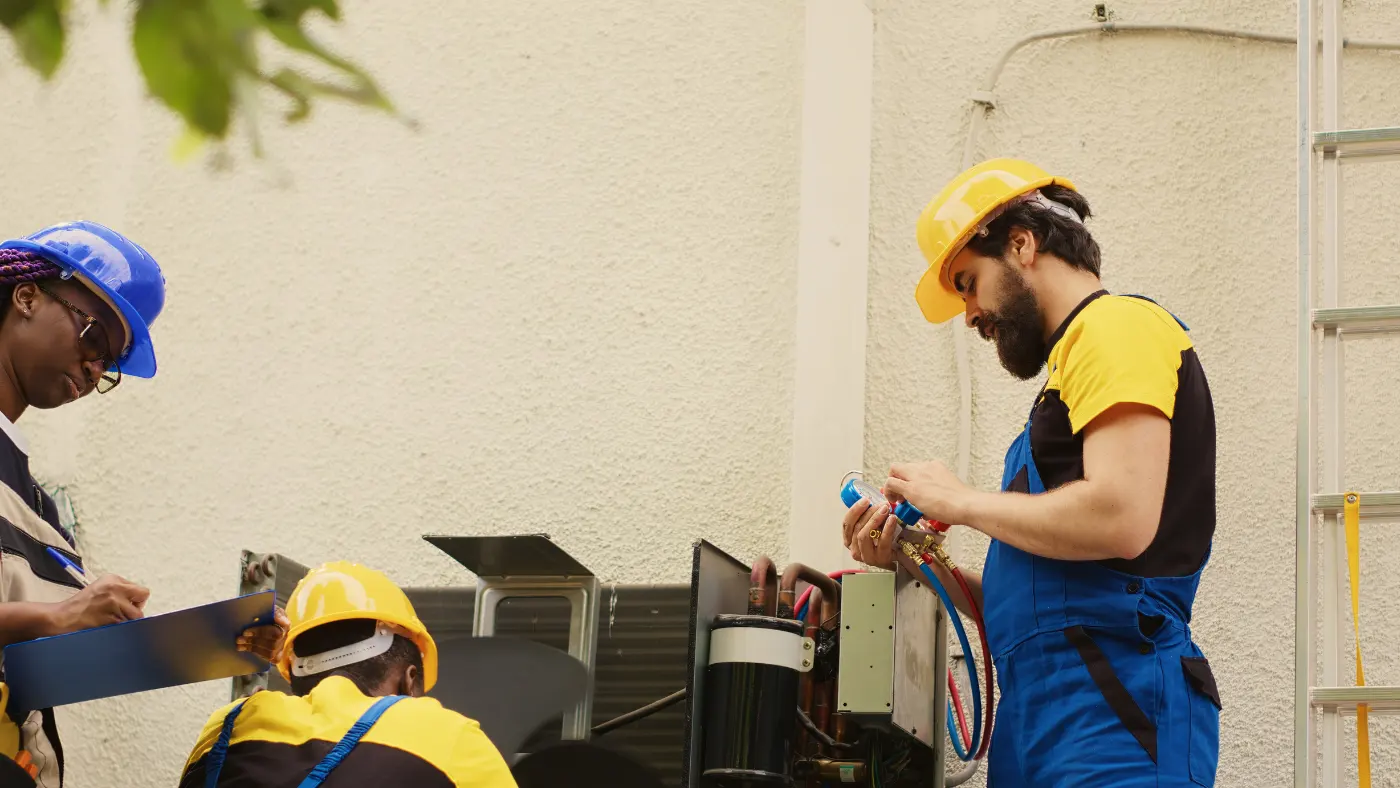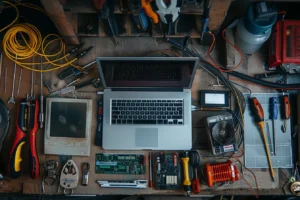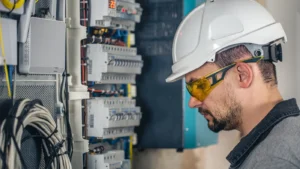Want to win more jobs with less effort?
Grow your business and send quick quotes with our home service software.

Electricians keep the lights on, both literally and figuratively, in homes, businesses, and industrial spaces across the country. As technology evolves and demand grows, skilled electricians are becoming more in demand.
In fact, employment of electricians is projected to grow 11% from 2023 to 2033, faster than average for many other professions. Despite this upward trend, there appears to be a current shortage of qualified professionals in the field.
Whether you’re considering entering the trade or looking to hire for your business, it helps to understand the different paths available. That’s why we’re breaking down the different types of electricians from the levels to the fields where they work to the skills that they need to be successful.
At Housecall Pro, we’re here to support growing trade professionals with tools and resources that help power their business forward.
What Are The Different Levels of Electricians?
Before we get into the specialties, it’s not a bad idea to understand the career ladder. Here’s a quick look at the different levels electricians can achieve as they gain training and experience.
Apprentice Electrician
An apprentice electrician is just beginning their career, learning through a combination of classroom instruction and hands-on experience under a licensed professional. While the average electrician earns around $61,391 annually ($29.51/hour), apprentices typically earn less, often between $15 and $20 per hour, as they build their skills and complete required training hours.
Journeyman Electrician
A journeyman electrician has completed their apprenticeship and passed a licensing exam, allowing them to work independently on wiring, installation, and repair jobs. They cannot yet supervise other electricians or pull permits. Journeymen typically earn between $25 and $35 per hour, depending on location and experience, placing their annual income well above that of apprentices.
Master Electrician
A master electrician is the highest level of electrician, requiring years of experience and successful completion of an advanced licensing exam. They can supervise teams, pull permits, and design entire electrical systems. With greater responsibility comes higher pay. Master electricians often earn between $35 and $50 per hour, with annual earnings well above the national average.
What Are The Different Fields Electricians Work in?
Not all electricians do the same type of work. Depending on their training and career path, electricians may specialize in residential, commercial, industrial, or maintenance fields. Here’s how they differ.
Residential Electricians
Residential electricians focus on homes, apartments, and other living spaces. They install, maintain, and repair wiring, outlets, circuit breakers, lighting fixtures, and more. These electricians are typically the ones called for home renovations, new builds, and everyday repairs. Their work ensures that residential electrical systems are safe, up to code, and fully functional.
Commercial Electricians
Commercial electricians work in businesses, offices, restaurants, schools, and retail spaces. Their responsibilities often involve larger-scale electrical systems than residential jobs, including complex lighting, security, and power distribution setups. These electricians may also install and maintain energy-efficient systems, work with blueprints, and ensure compliance with local codes and regulations for commercial properties.
Industrial Electricians
Industrial electricians operate in environments like factories and manufacturing plants, handling complex, high-voltage machinery and potentially hazardous materials. This necessitates specialized training and strict adherence to safety protocols beyond standard electrical work. These professionals wear PPE and undergo rigorous safety training to avoid arc flashes, shocks, and fire risks in demanding conditions.
Maintenance Electricians
Maintenance electricians focus on keeping electrical systems in good working order. They work in a variety of settings, including residential, commercial, or industrial, and are responsible for routine inspections, repairs, and system upgrades. Their role is essential for minimizing downtime, preventing malfunctions, and keeping everything from lighting to machinery operating safely and efficiently.
What Are The Different Electrician Job Types?
We just touched on the different fields that electricians work in, but the types of jobs they perform can vary even more. Some electricians focus on installing new systems, while others specialize in repairs, design, or working on vehicles, aircraft, or large infrastructure. Let’s take a closer look at the wide range of electrician job types.
Residential Electrician
Residential electricians specialize in home-based systems but may focus on specific tasks like new builds, home automation systems, or energy audits. They often work directly with homeowners, solving problems like overloaded circuits, adding dedicated lines for appliances, or installing smart home tech. This role demands strong interpersonal skills and a solid understanding of evolving household electrical needs.
Commercial Electrician
Commercial electricians may work on projects involving office buildings, retail outlets, or public spaces. Their tasks often include coordinating with HVAC technicians, fire alarm installers, and data cabling professionals. They ensure electrical systems support high-traffic use and may manage power distribution systems to accommodate complex commercial needs, including energy-efficient lighting and backup power solutions.
Industrial Electrician
These electricians work beyond standard electrical tasks, often interpreting detailed schematics for robotics, automation systems, and manufacturing lines. They troubleshoot sensors, PLCs (programmable logic controllers), and large motors. Their work can involve shift schedules and specialized knowledge of process control systems, all while maintaining safety in demanding industrial environments.
Maintenance Electrician
Maintenance electricians perform ongoing system checks and preventative services. They keep everything running by replacing worn parts, responding to electrical faults, and upgrading aging components. Whether in a school, hospital, or factory, they’re on-call to fix issues before they become major problems, reducing downtime and keeping operations on track.
Installation Electrician
Installation electricians focus on setting up new electrical systems. From running conduit and wiring to connecting fixtures and control systems, their job is all about getting systems operational from the ground up. They typically work during the construction or remodeling phase of a project and must coordinate with contractors and adhere to build timelines.
Automotive Electrician
Automotive electricians specialize in the electrical systems of vehicles, including wiring, lighting, air conditioning, battery systems, and increasingly, complex electronics in modern cars. With the rise of electric vehicles, their role is expanding to include high-voltage battery maintenance, vehicle diagnostics, and software-based troubleshooting using digital tools.
Construction Electrician
Construction electricians work on new builds, from homes and high-rises to bridges and tunnels. Their job starts with interpreting blueprints and includes laying out wiring systems, installing panels, and making sure everything passes inspections. Construction sites can be fast-paced, requiring adaptability and strong collaboration with other trades on-site.
Solar Panel Electrician
Also known as photovoltaic (PV) installers, these electricians install and connect solar energy systems. They ensure solar panels are positioned correctly, make rooftop connections, and tie systems into the home or building’s electrical grid. A solid grasp of both electrical and renewable energy systems is necessary, along with knowledge of solar inverters and battery storage.
Wind Turbine Electrician
Wind turbine electricians work at dizzying heights to install and maintain the electrical components of wind energy systems. They deal with control systems, generators, and power conversion equipment. The job requires physical fitness, climbing ability, and safety training for working in remote, elevated, and often weather-sensitive environments.
Marine Electrician
Marine electricians focus on boats and ships, handling everything from lighting and navigation to engine control and communications systems. Saltwater corrosion, confined spaces, and constantly moving platforms present unique challenges. These electricians must understand both DC and AC systems, along with the specialized wiring and fixtures used in marine environments.
Highway Systems Electrician
These electricians install and maintain roadway electrical systems, including traffic signals, street lighting, signage, and communication lines. They often work overnight or in low-traffic hours and must follow strict safety practices near moving vehicles. Their work helps keep traffic flowing and roadways safe for drivers and pedestrians alike. So, when you see them working on the road, be sure to give them some extra space for safety.
Avionics Electrician
Avionics electricians work on aircraft electrical systems, including navigation, communications, and flight control systems. Precision is critical, as even minor errors can impact flight safety. They follow strict aviation regulations and must be comfortable working in tight spaces, often with complex, shielded wiring and sensitive electronics.
Electrical Assembler
These professionals work primarily in manufacturing, assembling components like wiring harnesses, circuit boards, and control panels. They follow technical diagrams and use hand tools and testing equipment. Attention to detail is vital, as they’re often building products used in larger systems such as medical devices, industrial machinery, or aerospace equipment.
Lineperson (Lineman)
Linepersons work outdoors on overhead and underground power lines. They install, maintain, and repair electrical transmission and distribution systems that bring power to homes and businesses. This high-risk job often involves climbing utility poles or working from bucket trucks in all kinds of weather. Strong physical conditioning and safety awareness are a must.
Electrical Designer
Electrical designers create blueprints and technical plans for electrical systems in residential, commercial, or industrial projects. They use CAD software to draft layouts, calculate loads, and determine the placement of circuits and components. Their work forms the foundation for installers and contractors to accurately and safely bring the design to life.
Inside Wireperson
Inside wirepersons handle the wiring and systems inside buildings, often focusing on large-scale commercial and industrial settings. Their work includes connecting control panels, security systems, fire alarms, and power distribution. Unlike linemen who work outdoors, inside wirepersons are specialists in detailed, interior electrical setups requiring precision and code compliance.
Get In Touch: 858-842-5746
Let us earn your trust
On average, Pros increase monthly revenue generated through Housecall Pro by 50% after their first year.
See plan options and feature breakdown on our pricing page.
What Licenses and Certifications Are Required to Become an Electrician?
Becoming a licensed electrician takes more than just hands-on experience. It also involves meeting specific state or local requirements. Electrical licensing is a big part of the process, and the path often includes classroom instruction, on-the-job training, and passing exams. If you’re wondering how to become a journeyman or which electrician books and magazines can help you prepare, here’s what you need to know.
What’s The Highest Paying Electrician Position?
The highest-paying electrician roles typically require advanced training, certifications, and years of hands-on experience. According to our Electrician Salary Guide, master electricians and specialized roles tend to top the pay scale.
Top Earning Positions Include:
- Master Electrician: These experts oversee teams, design systems, and pull permits. They can earn over $90,000 annually, depending on location and industry.
- Industrial Electricians: Due to the complexity and hazards involved, industrial electricians often earn higher wages, up to $80,000 per year or more.
- Electrical Contractors or Business Owners: Running your own electrical business opens the door to six-figure earnings, but it also comes with the risk and responsibility of managing operations, clients, and compliance.
- Linemen and Powerline Installers: These outdoor professionals often face dangerous conditions but can make $75,000 to $95,000 annually, with overtime and hazard pay boosting total income.
Location, specialization, union membership, and demand all influence earning potential.
What Traits Should an Electrician Have?
Success as an electrician isn’t just about skill. It’s also about having the right mindset and character. These personal traits make a big difference:
- Detail-Oriented: Even small mistakes can lead to some pretty significant problems. Electricians must pay close attention to measurements, codes, and safety procedures.
- Problem Solver: Whether it’s a wiring issue or an overloaded panel, electricians need to think critically and troubleshoot in real time.
- Physically Fit: The job may require climbing ladders, lifting equipment, or working in tight spaces, so endurance and strength matter.
- Dependable: Timeliness and reliability are essential for working on projects and with teams that depend on coordination.
- Customer-Focused: Electricians often interact with homeowners, contractors, or business clients. Clear communication and professionalism go a long way.
These traits help electricians handle the demands of the job while building trust with clients and employers.
What Skills Should an Electrician Have?
Electricians need a wide range of technical and interpersonal skills to perform their jobs well and advance in their careers, many of which are commonly covered in electrician interview questions. Key skills include:
- Electrical Knowledge: A deep understanding of circuits, voltage, resistance, and current is foundational. This comes from training, reading electrician books, and real-world practice.
- Reading Blueprints and Schematics: Electricians must interpret plans to install or troubleshoot systems correctly.
- Tool Handling: From multimeters to conduit benders, electricians must safely and efficiently use a wide array of tools.
- Math Skills: Basic algebra and geometry help with measuring runs, calculating loads, and estimating materials.
- Code Compliance: Familiarity with the National Electrical Code (NEC) and local regulations is a must for safety and legal compliance.
- Communication: Clear verbal and written communication helps when working on teams, interpreting job instructions, or explaining issues to clients.
Exploring the Different Kinds of Electricians: What’s Next?
From residential installs to industrial repairs, the different kinds of electricians play instrumental roles in keeping our homes, businesses, and infrastructure running. Whether you’re starting out or leveling up, having the right tools makes all the difference. Now’s the time to pick up that electrician’s uniform, download the best electrician apps, and explore electrical contractor software that can help you manage scheduling, invoicing, and more. Housecall Pro offers a full suite of features designed to help electricians grow their business with less stress.
Ready to see it in action? Sign up for your free trial and power up your workflow today.






